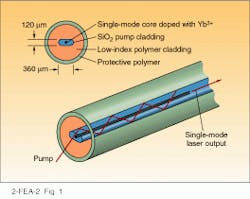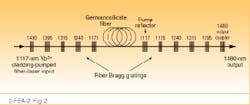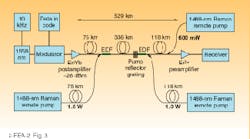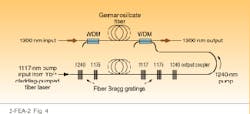Fiber Raman lasers emit at many wavelengths
Cascaded Raman resonators create flexible fiber lasers and amplifiers with high-power output at wavelengths from
1.1 to 2.0 ?m.
S. G. Grubb and A. J. Stentz
In conventional fiberoptic communications systems, optical powers are limited by the intrinsic material properties of single-mode diode lasers. These powers typically range from milliwatts for single-frequency signal diodes to tens of milliwatts for diode-laser pumps for erbium-doped fiber amplifiers. In contrast, recent advances in diode-array-pumped fiber-laser technology have boosted the available optical power in single-mode fibers by two orders of magnitude. These fiber-laser pumps have been used to obtain high-power 1.5-?m amplifiers by using codoped erbium/ytterbium (Er/Yb) fibers. Recently, outputs from
1.5-?m optical amplifiers of up to 4 W have been reported (see Laser Focus World, Nov. 1995, p. 9).
These systems experiments using launched optical powers of +26 dBm at 1.5 ?m have been performed by thorough suppression of nonlinear effects?notably stimulated Brillouin scattering (SBS) and four-wave mixing. However, there are cases where, given the availability of these high optical powers, one would like to maximize such nonlinear effects to construct useful devices. By optimizing the efficiency of stimulated Raman scattering through cascaded Raman resonators, useful laser or amplifier output can now be delivered at any wavelength from 1.1 to 2.0 ?m.
Raman fiber-laser progress
In stimulated Raman scattering, light is scattered by optical vibrational modes (optical phonons) of the material, resulting in frequency down-shifted Stokes light. In optical fibers doped with index-of-refraction-modifying germanium oxide (GeO2), this shift occurs at approximately 450 cm?1
(13.2 THz). Although the nonlinear cross section for this process is relatively weak in germanosilicate fibers, the long lengths and low loss of optical fibers more than compensate for the weak cross section.
The potential of fiber lasers based on Raman scattering was first demonstrated in the 1980s by Stolen, Lin, and coworkers at AT&T Bell Laboratories (Holmdel, NJ), where Raman lasers operating between 0.3 to 2.0 ?m were constructed.1 It was not clear from the early work that a Raman fiber laser could be pumped by a practical semiconductor-laser-based source or that an efficient CW-pumped Raman fiber laser would be possible. The recent development, however, of cladding-pumped fiber lasers2 and fiber Bragg gratings3 has made efficient, diode-laser-based CW Raman fiber lasers emitting at various wavelengths throughout the infrared (IR) a reality.
Cladding-pumped fiber lasers can generate nearly arbitrarily scalable, diode-pumped output power in a single-mode fiber. A cladding-pumped fiber relies on a large, separately light-guiding pump cladding that surrounds a much smaller rare-earth-doped single-mode core (see Fig. 1). Pump light from a high-power diode-laser array is focused into the pump cladding, which is typically 360 by 120 ?m. Ideally, the only pump-light loss mechanism is absorption by the rare-earth dopant in the single-mode core.
Feedback at the desired laser wavelength occurs only in the single-mode core and is provided by Bragg gratings functioning as mirrors. The gratings are the only technology available for placing a feedback element in the core. Laser power is extracted from the 7-?m-diameter core at efficiencies of up to 70%. Single-mode fiber outputs as high as 7 W have been obtained from ytterbium-doped cladding-pumped fiber lasers operating at 1.09 ?m. Unlike a simple system of lenses, cladding-pumped fibers allow the coupling of light from high-power diode-laser arrays into a single-mode fiber while actually increasing the radiance or brightness of the light by three orders of magnitude because the light is made diffraction-limited.
Bragg gratings define wavelength
Efficient conversion of this pump light to wavelengths throughout the IR by Raman fiber lasers also requires low-loss cavities for resonant feedback. Bragg gratings, written into the core of a single-mode fiber by exposure to ultraviolet light, can simultaneously provide extremely high reflectivities and out-of-band insertion losses of less than 0.1 dB. The ability to write in situ, highly reflecting, low-loss gratings with high transmission at both the pump and surrounding Stokes wavelengths is the second key enabling technology that permits the construction of extremely efficient, high-power CW Raman fiber lasers.
At each end of the laser cavity, which is several hundred meters of germanosilicate fiber, highly reflecting Bragg gratings for each of the intermediate Stokes frequencies permit efficient conversion of the output of an ytterbium-cladding-pumped fiber laser at 1117 nm via five Stokes frequency shifts to 1480 nm (see Fig. 2). The threshold of each Stokes cavity is lowered by the presence of two highly reflecting feedback elements at each end that also act to contain each Stokes order in the cavity such that the next Stokes order is intracavity-pumped.
We refer to these resonators as cascaded Raman lasers. The Raman cascade is terminated by the presence of a suitable output coupler grating, with reflectivity around 20%, which extracts power at the desired wavelength. We have been able to obtain diode-pumped, single-mode-fiber output powers of
1.7 W at 1480 nm at a slope conversion efficiency of 46%.4 Using a flashlamp-pumped Nd:YAG laser as the Raman laser pump source, we have obtained output powers as high as 2.6 W at
1480 nm. The spectral output of the laser is approximately 2 nm FWHM and is controlled by the width of the highly reflecting Bragg grating. These high-power 1480-nm Raman lasers were an enabling part of the 529-km repeaterless transmission experiment at 2.5 Gbit/s (see Laser Focus World, October 1995,
p. 13, and Fig. 3).5
In remote pumping, where the goal is to maximize the distance between active repeaters, one desires high-power 1480-nm pump sources at the terminal ends. This pump light is then transmitted along the fiber path from each end to pump a passive section of erbium-doped fiber spliced into the transmission line at tens of kilometers from the terminal end. The linewidth of the high-power Raman lasers is sufficiently broad that one can transmit more than 1.2 W?the highest single-mode fiber-coupled power reported at 1480 nm?without being limited by SBS. A cascaded Raman laser is required because there are currently no rare-earth-doped silica fiber-laser approaches that are viable at 1480 nm.
Because the Raman-process bandwidth is broad (more than 20 THz), a significant amount of tuning can be accomplished by adjustment of the resonant wavelength of each of the Bragg reflector gratings. By systematically shifting the wavelengths of the intermediate Stokes orders, we can obtain virtually any down-shifted wavelength from the cladding-pumped laser output. Because one is no longer constrained to particular transitions of rare-earth elements, CW laser or amplifier output at wavelengths from 1.1 to 2.0 ?m can be readily obtained. Additionally, by use of a broad, highly reflective Bragg grating at the terminal Stokes frequency and a tunable output coupling element, it should be possible to obtain high-power, diode-pumped tunable output over a few tens of nanometers centered around virtually any point in this wavelength range.
Raman amplifiers
It is also possible to construct high-gain Raman amplifiers at virtually any wavelength by terminating a Raman laser one Stokes order short of where amplification is desired and then injecting a signal through this resonant structure. Because the majority of terrestrial communications systems currently operate in the second communications window at wavelengths near 1.3 ?m, a high-gain, low-noise, silica-fiber-based amplifier would be an attractive component for these systems.6,7 We have demonstrated such a cascaded Raman amplifier with gains in excess of 40 dB and output powers of greater than +24 dBm.
Although measurements have shown that the signal-spontaneous beat noise of these amplifiers can be as low as
4.2 dB, systems tests of these Raman amplifiers have identified some additional noise sources that are absent in erbium-doped fiber amplifiers at
1.5 ?m. A major source of noise is the coupling of intensity fluctuations in the pump laser to the signal caused by the lack of a long upper-state lifetime, such as is present in erbium-doped fiber amplifiers, to buffer the Raman gain from fluctuations in the pump intensity.
But when the pump and signal are counterpropagated through the amplifier, the pump fluctuations are averaged over the transit time of the several-
kilometer-long amplifier, and the pump-signal crosstalk is significantly reduced.
It is thus advantageous to generate the pump light at 1240 nm from a cladding-pumped cascaded Raman laser and then counterpropagate this pump and the 1.3-?m signal in a separate section of germanosilicate fiber (see Fig. 4). Using this geometry, we have been able to demonstrate acceptable system performance of a 1.3-?m digital Raman power amplifier. No power penalty was observed in the 2.5-Gbit/s bit-error-rate test at an amplifier net gain of 30 dB and an output power of +16 dBm.
Given the power and flexibility of cascaded Raman lasers and amplifiers, numerous additional applications for these devices are likely to emerge. n
REFERENCES
1. R. Stolen and C. Lin, CRC Handbook of Laser Science and Technology, Supplement 1: Lasers, M. J. Weber, ed., CRC Press, Boca Raton, FL (1991).
2. H. Po et al., Electron. Lett. 29(17), 1500 (1993).
3. G. Meltz, W. W. Morey, and W. H. Glenn, Opt. Lett, 14, 823 (1989).
4. S. G. Grubb et al., OSA Topical Meeting: Optical Amplifiers and Their Applications, paper SaA4, Davos, Switzerland (1995).
5. P. B. Hansen et al., Electron. Lett. 31(17), 1460 (1995).
6. S. G. Grubb et al., OSA Topical Meeting: Optical Amplifiers and Their Applications, paper PD3, Breckenridge, CO (1994).
7. E. M. Dianov et al., Quant. Electron. 24(9), 749 (1994).
FIGURE 1. A relatively large pump cladding surrounds the 7-?m-diameter ytterbium-doped single-mode core in a Raman fiber laser.
FIGURE 2. Using ultraviolet light, five pairs of Bragg gratings are written into the ends of the laser cavity, along with a 1480-nm output-coupler grating, forming a high-power fifth-order cascaded Raman laser.
FIGURE 3. Three high-power 1488-nm Raman sources at the terminal ends were used to pump
passive erbium-doped-fiber (EDF) sections stationed up to 118 km apart in a 529-km repeaterless transmission experiment operating at 2.5 Gbit/s.
FIGURE 4. A 1.3-?m Raman amplifier features a cascaded Raman laser generating 1240-nm pump light that is then counterpropagated along with the 1.3-mm signal, via wavelength division
multiplexers (WDMs), in the germanosilicate fiber section.



